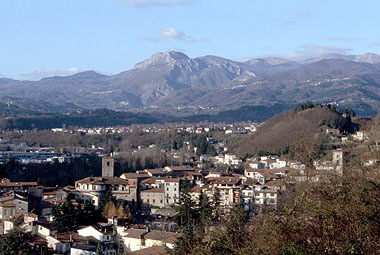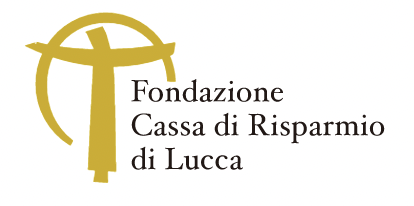
In order to sketch an outline of the events that took place in the Serchio valley since the Middle Ages we must refer in first place to the heritage left by the Lombards: the reflex of this people's culture, indeed, reaches until the dawning of the new millennium (ca. 1000 a.D.) when important social and territorial changes occurred.
Such phenomena, on an Italian or even European scale, are marked by a rapid increase of the population, a better control over the territory thanks to drainage works and the more intensive cultivation of the land, the creation of new roads or the repair of the existing ones, the development of villages and finally the reorganisation of political and religious power on the basis of so called "pievi" (parishes), centres from which Christianity could rapidly spread.
Rural lordship is concentrated in the hands of Lombard clans (such as the Suffredinghi, Rolandinghi and others) as they emerge in the wake of the disintegrating central power at the end of the Carolingian Age.
The rural communities that had, until then, benefited from the lands belonging to the Church or great lay lords, whose presence was felt only when tithes and tributes had to be paid, become aware of the changes due to the direct exercise of power on the territory and the progressive consolidation of the seigniories.
The consolidation of local political power was accompanied by a gradual erosion of feudal bonds and concessions, replaced by the system of permanent leasing that led to a redistribution of the land with an unusual (at least for the Lucca region) fragmentation and dispersion of property in the Serchio valley.
The process was further accelerated when large feuds such as that of Countess Matilde were split or changed hands.
Details:
This general process of modernisation and reorganisation of the defensive system, in several stages, ended at the beginning of the XVIIIth century; in coincidence with the achievement of political stability and the settlement of old frontier disputes due to Lucca's never appeased ambition to regain possession of the Upper Serchio valley engendering long and bloody periods of war.
So the fortifications became barracks with garrisons guarding stable frontiers; only now and then were they involved in large scale military events, when troops crossed their territory for questions of national importance.
Thus, from the XVIIIth century on, begins a slow but inexorable process of demobilisation culminating in the XIXth with the sale of many fortifications to private owners and their transformation into houses or agricultural land. Recently the local administration is making an effort to buy these buildings and renovate them with the aim of preserving them for tourists and historians.
The outline of these castles and towers has become one with the valley's landscape and still crowns the hilltops: a witness to long past political events and episodes of war.
The passage of most of Garfagnana's communities under the Dukes of Este is a major event for the political order in the valley: a new power, until then in no way related to this area, suddenly alters a delicate balance with all her considerable weight. The population willingly accepted this domination that lasted nearly continuously for more than 400 years granting Garfagnana a long and profitable period of administrative stability.
It is then that the territory of the Serchio valley was definitively divided between different states: the Republic of Lucca in the south, the Florentine Medici in Barga, the Ferrarese Dukes of Este in the north and the Malaspina towards Lunigiana. The presence of a number of enclaves, small islands belonging to one state on the territory of another (Castiglione and Minucciano) and land "pockets" like that of the Medici of Barga in the Lucchese state, complicates the difficult problem of the frontiers.
This fragmentation of frontiers and the establishment of a new territorial balance led, between the XVth and XVIth century, to the creation, reinforcement or repair of military structures along the boundaries and in the administrative centres together with the construction ex novo of large military complexes suited to the demands of modern warfare.
A revolution in military architecture takes place in these years: the high thin curtain walls disappear and low thick ones capable of absorbing the energy of shells and of sheltering heavy artillery to answer the enemy fire take their place; the walls of Lucca represent a fine example of this.
We can see this change also in the Serchio valley where thin Medieval walls are thickened with massive curtains and the insertion of towers and bastions (Camporgiano, Ceserana, ecc.) while buildings that cannot be adapted are demolished to reuse the construction material for modern fortifications (Verrucole) or finally brand new fortresses and wall circles are projected and constructed ex novo (Montalfonso, Cascio).
After the communities of the Serchio valley were legally recognised as such for the first time by a charter of emperor Federico Ist in 1185, a new class of small land owners begins to emerge thanks to the exploitation and gradual division of new lands into smaller and smaller plots.
We can affirm that the settlement pattern in the Serchio valley was nearly completely defined by the year 1000: indeed, 90% of today's villages were already present. Their disposition on the territory is fruit of a deliberate choice taking into account military reasons, such as the presence of streams offering a natural defence, or economical ones, so as to better exploit the agricultural resources.
Around the year 1100 begins the systematic fortification of the Serchio valley; the nobles and the bishop's tenants detain, de facto, locally all political power thanks to imperial privileges and, though to a lesser account, also have military control of the region.
In this period the defensive system is rather complex and in part still based on that of probable Lombard origin with watchtowers controlling the border regions. The word Castellum, referred to a number of different places and settlements such as rocche with a small military garrison or fortified mansions where the lord resided, makes its appearance around the year 1000.
The historical events that led to their abandon or decline, together with natural causes of deterioration or traumatic events such as destruction or earthquakes, have determined the loss of this close net of fortifications that are remembered, in some cases, only by placenames or archival records. Research, however, is under way with excavations or surface explorations that have proved the existence of a large number of such fortifications, usually consisting of rather modest buildings surrounded by walls that follow the morphology of the ground together with a tower on a quadrangular base; the surviving architectonic elements, in many cases no more than the foundations, consist of sections of wall with squared or hewn stone blocks arranged "a filaretto" and narrow openings covered by strong monolithic architraves or stone arches made of regular ashlars. The delicate balance of power between local seignory, Church's feuds and communal rights was gradually upset, from the XIIIth century onwards, by the ambitions of Lucca, rivalled by enemy towns and feudal leagues ("consorterie"), with phases marked by the alternating presence and involvement of all opposed political factions; by 1308 the entire Serchio valley was under the rule of Lucca and divided into six vicariates; the communal rights and competence granted by the charters gradually lost all substantial meaning, the charters themselves demoted to mere municipal regulations, so that the communes were deprived of their political independence and all decisions were henceforth taken in Lucca.





